Modelling of Fracture Toughness of X80 Pipeline Steels in DTB Transition Region Involving the Effect of Temperature and Crack Growth
Abstract
1. Introduction
2. Experimental Details
2.1. Material Description
2.2. Weld Thermal Simulation Technique
2.3. The True Stress-Strain Curves
2.4. Specimen Configurations and Test Program
3. Numerical Procedures
3.1. 3D Finite Element Models
3.2. The MBL (Modified Boundary Layer) Model
4. Results and Discussion
4.1. Measured and Calculated Load-CMOD Curves
4.2. Measured CTOD-Values and Calculated Q-CTOD Relations at Different Temperatures
4.3. Measured and Calculated CTOD-CMOD Relations
4.4. The Effect of Crack Growth on the CTOD-CMOD Relations
4.5. The Influence of 3D Effect on the Fracture Toughness
5. Conclusions
- (1)
- The HAZ of X80 hardening behavior exhibits a slight effect of temperature variations, which indicates the crack tip constraint is less dependent on the temperature as also observed from 3D FEA results.
- (2)
- The predicted load-CMOD curves from 3D models are in good accordance with experimental results at all temperatures. As for the local fracture parameter, as depicted with the CTOD-CMOD relationship, the experimental data for the SENB specimens can be quite well simulated by 3D simulations without considering crack growth. For the SENT specimens, a good agreement between experiments and numerical simulations can also be obtained by considering the effect of crack growth in the 3D models.
- (3)
- The tested CTOD-values show considerable scatter but confirm well-established trends of increasing toughness with increasing temperature and reducing constraint.
- (4)
- Cleavage fracture can be clearly observed for SENB specimens at all tested temperatures, while ductile crack growth can be seen for SENT specimens at −30 °C and 0 °C.
- (5)
- From 3D finite element analyses, it has been found out that the CTODs change considerably through the specimen thickness. The predicted CTODs near the mid-thickness layer is coincident well with the experiments for the SENT specimens at 0 °C and −30 °C. The greater the distance from the specimen mid-thickness, the greater the deviation from experiments.
Author Contributions
Funding
Acknowledgments
Conflicts of Interest
References
- Mathias, L.L.; Sarzosa, D.F.; Ruggieri, C. Effects of specimen geometry and loading mode on crack growth resistance curves of a high-strength pipeline girth weld. Int. J. Press. Vessels Pip. 2013, 110, 12–22. [Google Scholar] [CrossRef]
- McMeeking, R.M.; Parks, D.M. On Criteria for J-Dominance of Crack-Tip Fields in Large-Scale Yielding. In ASTM STP 668 Elastic-Plastic Fracture; Landes, J.D., Ed.; ASTM International: Philadelphia, PA, USA, 1979; pp. 175–194. [Google Scholar]
- Shih, C.F.; German, M.D. Requirements for a one parameter characterization of crack-tip fields by the HRR singularity. Int. J. Fract. 1981, 17, 27–43. [Google Scholar]
- Sorem, W.A.; Dodds, R.H.; Rolfe, S.T. Effects of crack depth on elastic-plastic fracture toughness. Int. J. Fract. 1991, 47, 105–126. [Google Scholar] [CrossRef]
- Joyce, J.A.; Link, R.E. Ductile-to-brittle transition characterization using surface crack specimens loaded in combined tension and bending. In ASTM STP 1321 Fatigue and Fracture Mechanics; Underwood, J.H., Macdonald, B., Mitchell, M., Eds.; ASTM International: Philadelphia, PA, USA, 1997; Volume 28, pp. 243–262. [Google Scholar]
- Dodds, R.H., Jr.; Shih, C.F.; Anderson, T.L. Continuum and micromechanics treatment of constraint in fracture. Int. J. Fract. 1993, 64, 101–133. [Google Scholar]
- Dodds, R.H., Jr.; Nevalainen, M. Numerical investigation of 3-D constraint effects on brittle fracture in SE (B) and C (T) specimens. Int. J. Fract. 1996, 74, 131–161. [Google Scholar]
- Naumenko, V.P.; Limanskii, I.V. Fracture resistance of sheet metals and thin-wall structures. Part 1. critical review. Strength Mater. 2014, 46, 18–37. [Google Scholar] [CrossRef]
- Betegon, C.; Hancock, J.W. Two-parameter characterization of elastic-plastic crack-tip fields. J. Appl. Mech. 1991, 58, 104–110. [Google Scholar] [CrossRef]
- O’Dowd, N.P.; Shih, C.F. Family of crack-tip fields characterized by a triaxiality parameter-I. Structure of fields. J. Mech. Phys. Solids 1991, 39, 989–1015. [Google Scholar] [CrossRef]
- O’Dowd, N.P.; Shih, C.F. Family of crack-tip fields characterized by a triaxiality parameter-II. Fracture application. J. Mech. Phys. Solids 1991, 40, 939–963. [Google Scholar] [CrossRef]
- Bose-Filho, W.W.; Carvalho, A.L.M.; Stragwood, M. Effects of alloying elements on the microstructure and inclusion formation in HSLA multipass welds. Mater. Charact. 2007, 58, 29–39. [Google Scholar] [CrossRef]
- Das, S.K.; Sivaprasad, S.; Das, S.; Chatterjee, S.; Tarafder, S. The effect of variation of microstructure on fracture mechanics parameters of HSLA-100 steel. Mater. Sci. Eng. A 2006, 431, 68–79. [Google Scholar] [CrossRef]
- Bose Filho, W.W.; Carvalho, A.L.M.; Bowen, P. Micromechanisms of cleavage fracture initiation from inclusion in ferritic welds: Part, I. Quantification of local fracture behavior observed in notched test pieces. Mater. Sci. Eng. A 2007, 460–461, 436–452. [Google Scholar] [CrossRef]
- Lambert-Perlade, A.; Gourgues, A.F.; Besson, J.; Sturel, T.; Pineau, A. Mechanisms and modeling of cleavage fracture in simulated heat-affected zone microstructures of a high-strength low alloy steel. Metall. Mater. Trans. A 2004, 35, 1039–1053. [Google Scholar] [CrossRef]
- Mohseni, P.; Solberg, J.K.; Karlsen, M.; Akselsen, O.M.; Østby, E. Investigation of mechanism of cleavage fracture initiation in intercritically coarse grained heat affected zone of HSLA steel. Mater. Sci. Technol. 2012, 28, 1261–1268. [Google Scholar] [CrossRef]
- Moeinifar, S.; Kokabi, A.H.; Hosseini, H.R.M. Influence of peak temperature during simulation and real thermal cycles on microstructure and fracture properties of the reheated zones. Mater. Des. 2010, 31, 2948–2955. [Google Scholar] [CrossRef]
- Zhang, Z.L.; Hauge, M.; Thaulow, C. Two-parameter characterization of near-tip stress fields for a bi-material elastic-plastic crack. Int. J. Fract. 1996, 79, 65–83. [Google Scholar] [CrossRef]
- Thaulow, C.; Hauge, M.; Zhang, Z.L.; Ranestad, O.; Fattorini, F. On the interrelationship between fracture toughness and material mismatch for cracks located at the fusion line of weldments. Eng. Fract. Mech. 1999, 64, 367–382. [Google Scholar] [CrossRef]
- Ren, X.B.; Zhang, Z.L.; Nyhus, B. Effect of residual stresses on the crack-tip constraint in a modified boundary layer model. Int. J. Solids Struct. 2009, 46, 2629–2641. [Google Scholar] [CrossRef]
- Sisodia, R.P.S.; Gáspár, M. Physical simulation-based characterization of HAZ properties in steels. part 1. high-strength steels and their hardness profiling. Strength Mater. 2019, 51, 490–499. [Google Scholar] [CrossRef]
- Mandziej, S.T. Physical simulation of metallurgical processes. Mater. Technol. 2010, 44, 105–119. [Google Scholar]
- Gáspár, M. Effect of Welding Heat Input on Simulated HAZ Areas in S960QL High Strength Steel. Metals 2019, 9, 1226. [Google Scholar] [CrossRef]
- Lukács, J.; Dobosy, Á. Matching effect on fatigue crack growth behaviour of high-strength steels GMA welded joints. Weld. World 2019, 63, 1315–1327. [Google Scholar] [CrossRef]
- Xu, J.; Li, P.; Fan, Y.; Sun, Z. Effect of temperature on fracture toughness in weld thermal. simulated X80 pipeline steels. Trans. China Weld. Inst. 2017, 38, 22–26. [Google Scholar]
- Qiu, H.; Mori, H.; Enoki, M.; Kishi, T. Fracture mechanism and toughness of the welding heat-affected zone in structural steel under static and dynamic loading. Metall. Mater. Trans. 2000, 31, 2785–2791. [Google Scholar] [CrossRef]
- British Standards Institution. BS-7448-2: Fracture Mechanics Toughness Tests. Part 2: Method for Determination of KIc, Critical CTOD and Critical J Values of Welds in Metallic Materials; BSI: London, UK, 1997. [Google Scholar]
- Det Norske Veritas. Fracture control for pipeline installation methods introducing cyclic plastic strain. In Recommended Practice DNV-rp-f108; Det Norske Veritas: Høvik, Norway, 2006. [Google Scholar]
- ABAQUS. ABAQUS User Manual, version 6.14; Dassault Systemes Simulia Corp.: Providence, RI, USA, 2014. [Google Scholar]
- Xu, J.; Zhang, Z.L.; Østby, E.; Nyhus, B.; Sun, D.B. Constraint effect on the ductile crack growth resistance of circumferentially cracked pipes. Eng. Fract. Mech. 2010, 77, 671–684. [Google Scholar] [CrossRef]
- Eikrem, P.A.; Zhang, Z.L.; Nyhus, B. Effect of plastic prestrain on the crack tip constraint of pipeline steels. Int. J. Press. Vessels Pip. 2007, 84, 708–715. [Google Scholar] [CrossRef]
- Xu, J.; Zhang, Z.L.; Østby, E.; Nyhus, B.; Sun, D.B. Effect of crack depth and specimen size on ductile crack growth of SENT and SENB specimens for fracture mechanics evaluation of pipeline steels. Int. J. Press. Vessels Pip. 2009, 86, 787–797. [Google Scholar] [CrossRef]
- Ren, X.B.; Zhang, Z.L.; Nyhus, B. Effect of residual stresses on ductile crack resistance. Eng. Fract. Mech. 2010, 77, 1325–1337. [Google Scholar] [CrossRef]
- Zhang, Z.L.; Thaulow, C.; Ødegård, J. A complete Gurson model approach for ductile fracture. Eng. Fract. Mech. 2000, 67, 155–168. [Google Scholar] [CrossRef]


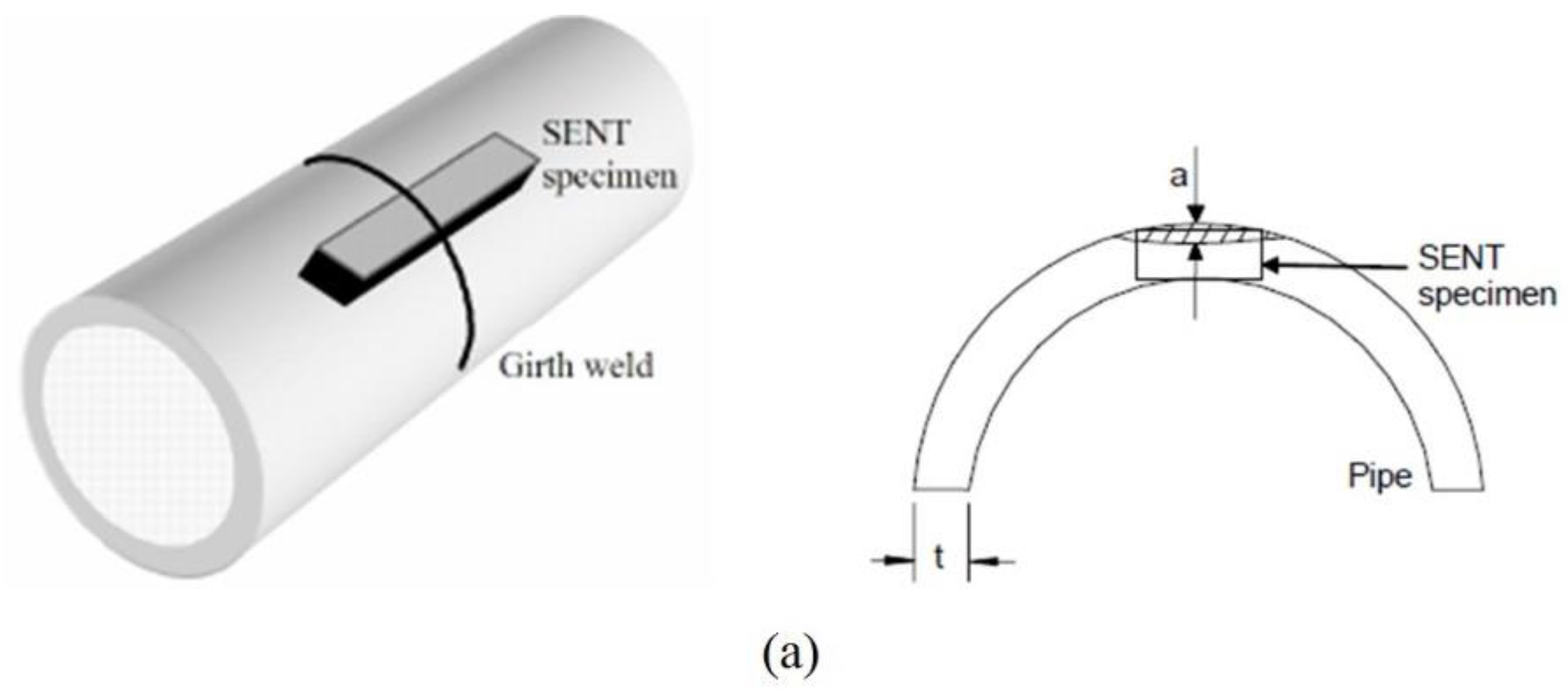





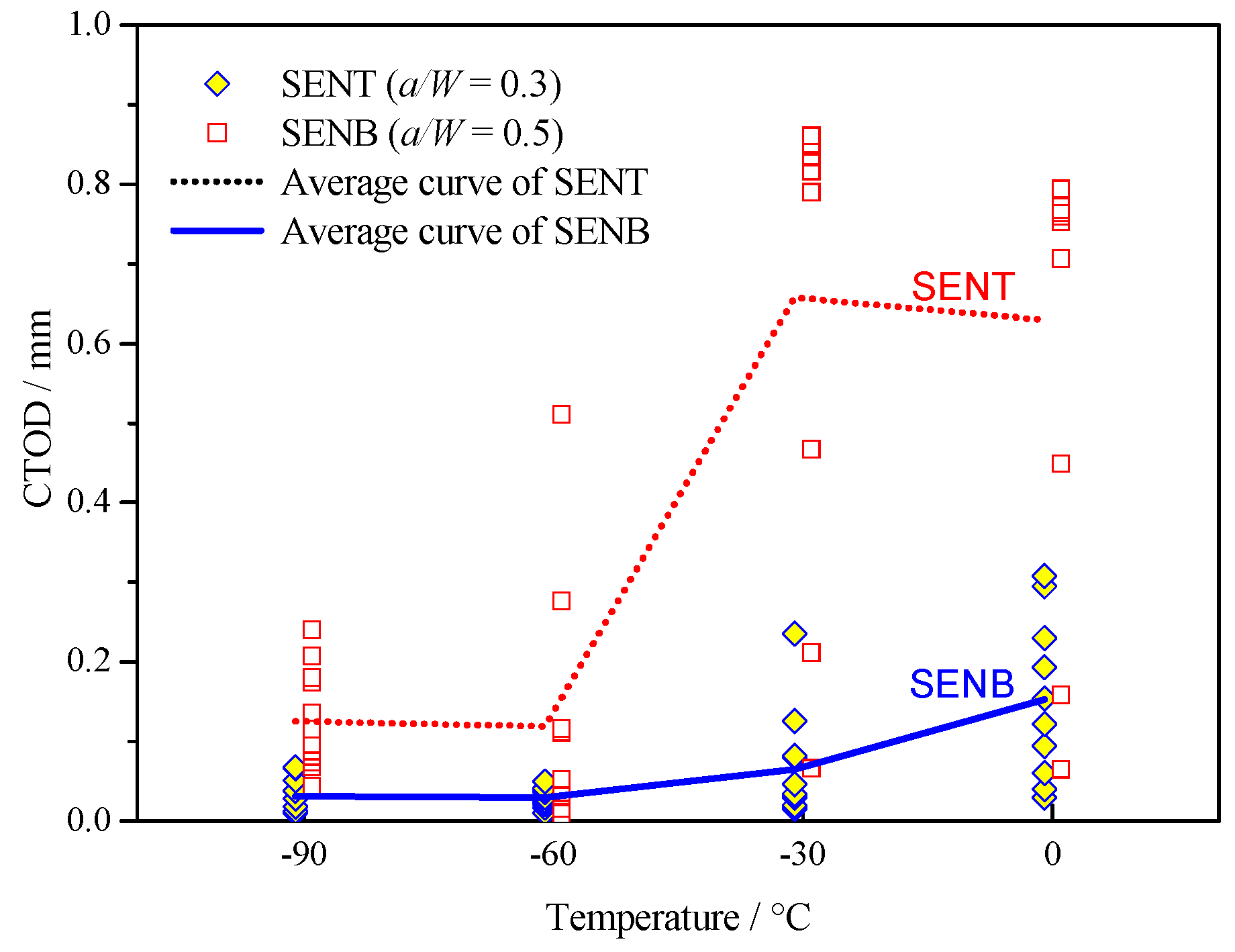
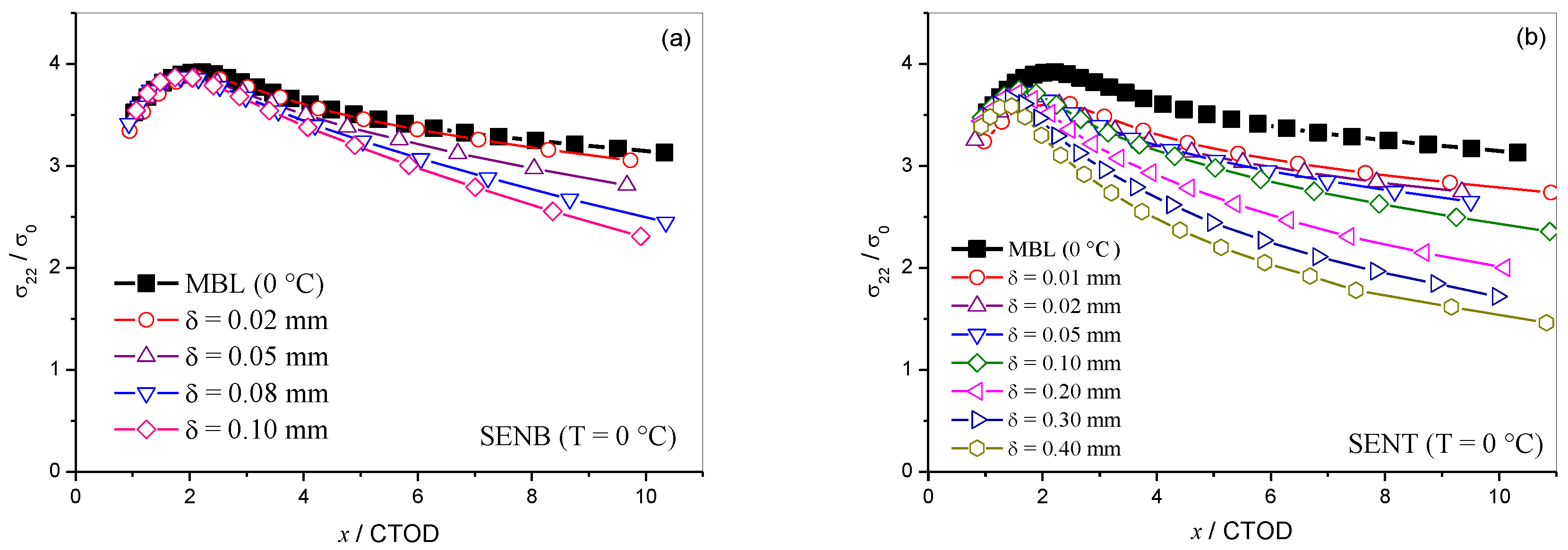


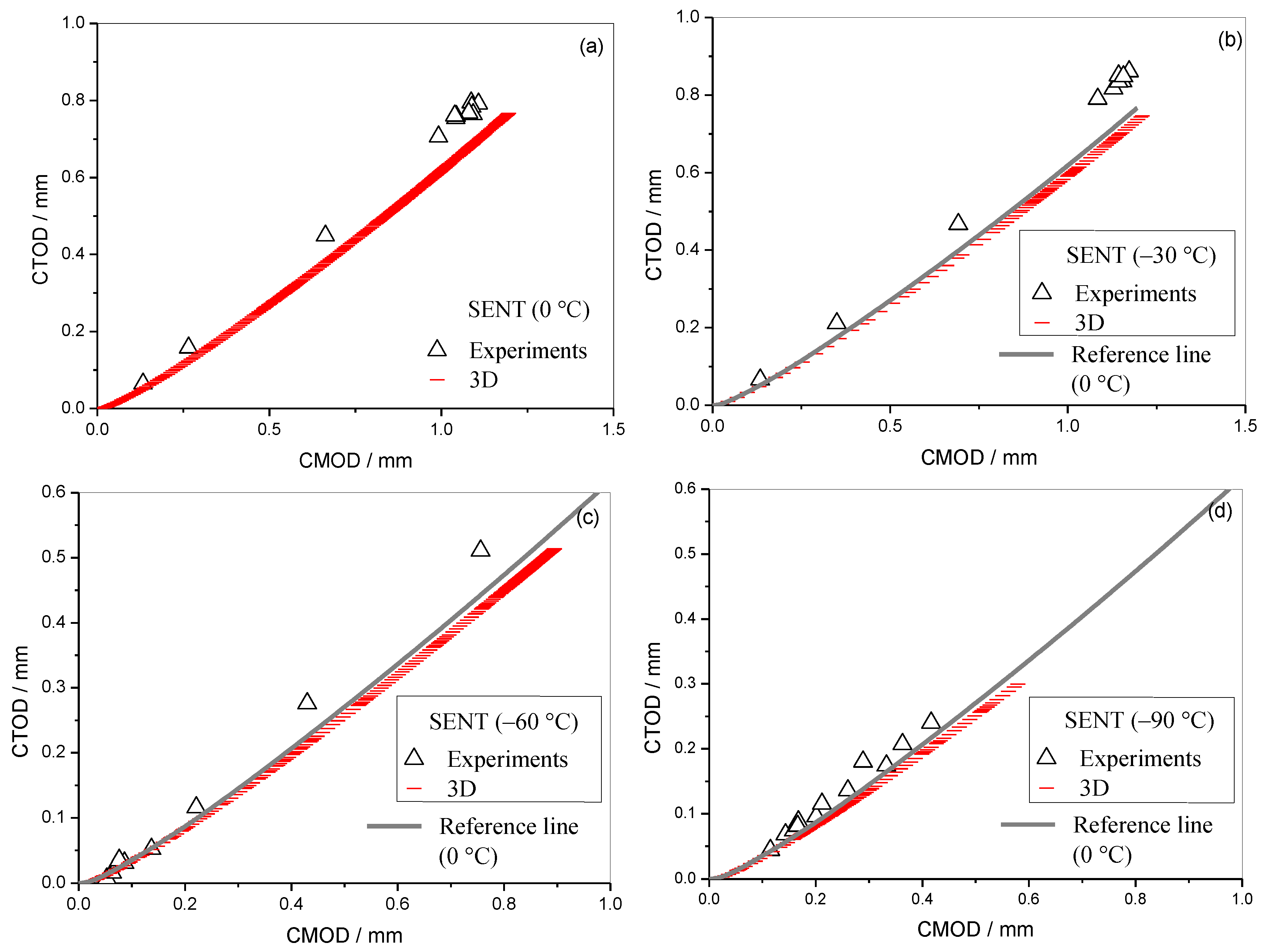
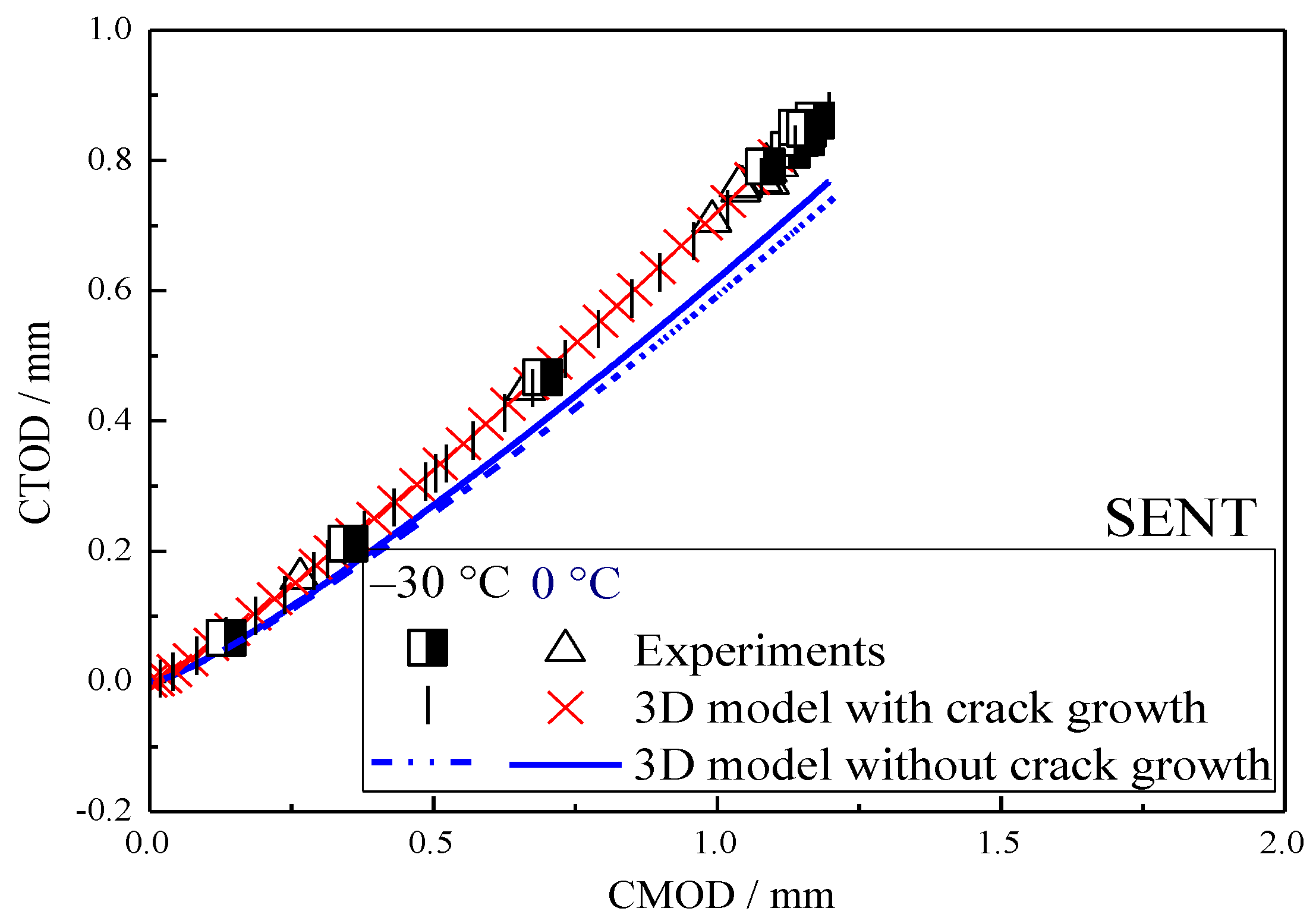
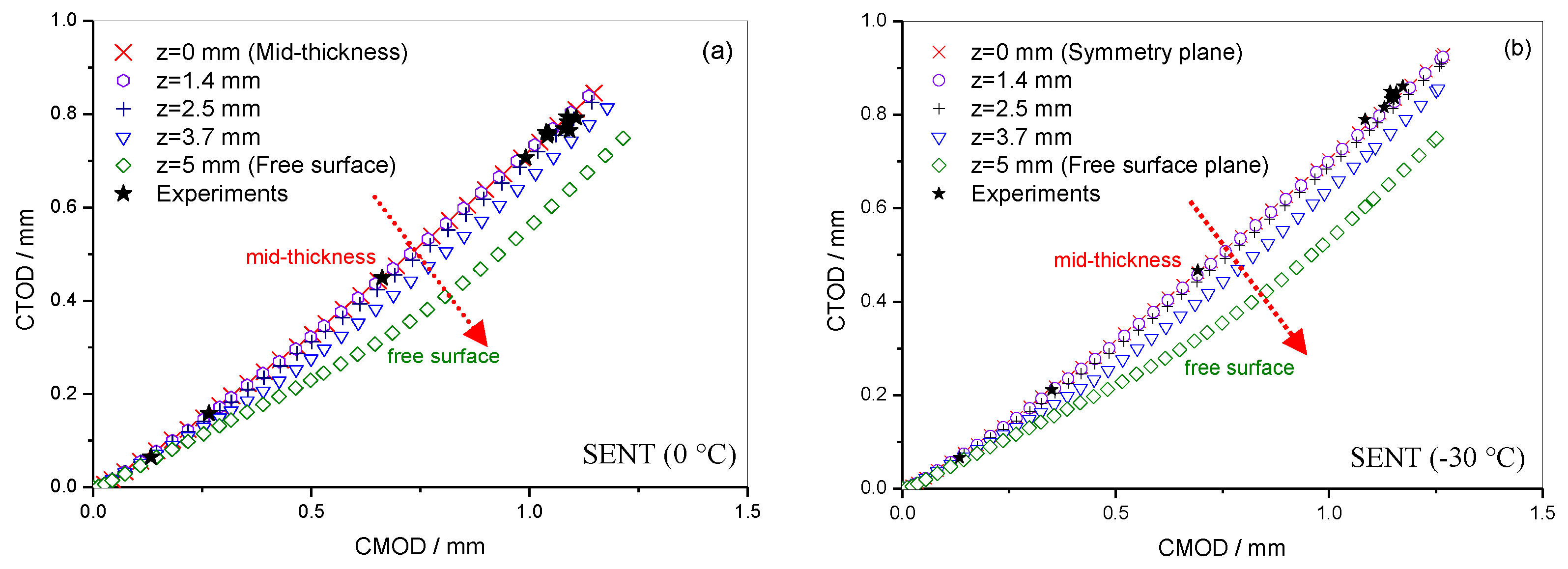
| Steel | C | Si | Mn | P | S | Others |
|---|---|---|---|---|---|---|
| X80 | 0.04~0.07 | ~0.25 | ≤1.8 | ≤0.01 | ≤0.001 | Mo, Ni, Cu, Ti, Nb, V, Al |
| Specimens | Statistical Characteristics | −90 °C | −60 °C | −30 °C | 0 °C |
|---|---|---|---|---|---|
| SENB | Average values (mm) | 0.031 | 0.029 | 0.065 | 0.152 |
| Standard deviation | 0.021 | 0.011 | 0.064 | 0.096 | |
| Standard deviation coefficient | 0.703 | 0.392 | 0.979 | 0.632 | |
| SENT | Average values (mm) | 0.125 | 0.119 | 0.658 | 0.63 |
| Standard deviation | 0.055 | 0.151 | 0.284 | 0.098 | |
| Standard deviation coefficient | 0.439 | 1.274 | 0.432 | 0.155 |
© 2019 by the authors. Licensee MDPI, Basel, Switzerland. This article is an open access article distributed under the terms and conditions of the Creative Commons Attribution (CC BY) license (http://creativecommons.org/licenses/by/4.0/).
Share and Cite
Xu, J.; Song, W.; Cheng, W.; Chu, L.; Gao, H.; Li, P.; Berto, F. Modelling of Fracture Toughness of X80 Pipeline Steels in DTB Transition Region Involving the Effect of Temperature and Crack Growth. Metals 2020, 10, 28. https://doi.org/10.3390/met10010028
Xu J, Song W, Cheng W, Chu L, Gao H, Li P, Berto F. Modelling of Fracture Toughness of X80 Pipeline Steels in DTB Transition Region Involving the Effect of Temperature and Crack Growth. Metals. 2020; 10(1):28. https://doi.org/10.3390/met10010028
Chicago/Turabian StyleXu, Jie, Wei Song, Wenfeng Cheng, Lingyu Chu, Hanlin Gao, Pengpeng Li, and Filippo Berto. 2020. "Modelling of Fracture Toughness of X80 Pipeline Steels in DTB Transition Region Involving the Effect of Temperature and Crack Growth" Metals 10, no. 1: 28. https://doi.org/10.3390/met10010028
APA StyleXu, J., Song, W., Cheng, W., Chu, L., Gao, H., Li, P., & Berto, F. (2020). Modelling of Fracture Toughness of X80 Pipeline Steels in DTB Transition Region Involving the Effect of Temperature and Crack Growth. Metals, 10(1), 28. https://doi.org/10.3390/met10010028






